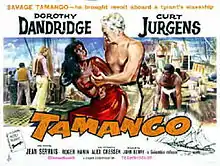Tamango
Tamango is a 1958 French/Italian film directed by John Berry, a black-listed American director who exiled himself to Europe. Dorothy Dandridge and Curd Jürgens (billed as: Curt Jurgens) star in the film with co-stars Alex Cressan and Jean Servais. Based on the short story by Prosper Mérimée[1] first published in 1829,[2] the film is about a slave ship on its crossing from Africa to Cuba, the various people it carries and the slaves' rebellion while on board.
| Tamango | |
|---|---|
 American version of Tamango poster | |
| Directed by | John Berry |
| Written by | Prosper Mérimée John Berry Lee Gold Tamara Hovey Georges Neveux (dialogue) |
| Starring | Dorothy Dandridge Curd Jürgens Alex Cressan Jean Servais |
| Music by | Joseph Kosma |
| Cinematography | Edmond Séchan |
| Edited by | Roger Dwyre |
| Distributed by | CEI Incom |
Release date | January 24, 1958 (France) September 16, 1959 (official United States release date) |
Running time | 98 minutes |
| Country | Italy/France |
| Language | English/French |
Plot
Captain Reiker (Curd Jürgens), a Dutch sea captain, sets off on what he intends to be his last slave-ship voyage. After capturing slaves with the complicity of an African chief (Habib Benglia), he then starts his voyage for Cuba. Along with the slaves below-deck, the passengers include his mistress, the slave Aiché (Dorothy Dandridge), and the ship's doctor, Doctor Corot (Jean Servais). Tamango (Alex Cressan), one of the captured men, plans a revolt and tries to persuade Aiché to join him and the other slaves. When the captured slaves do rebel, Tamango manages to hold Aiché hostage. A deadlock between the two sides then develops and Captain Renker states he will fire a cannon into the ship’s hold and kill all the slaves unless they give up. Aiché is given a chance to leave by Tamango but after looking up the ladder that leads out of the hold (and towards life), chooses to stay with her fellow slaves. The captain makes good on his threat and shoots the cannon into the hold, literally silencing the slaves' songs.[3][4]
Controversies
The film was controversial in different parts of the world. Even though the project was filmed in the French city Nice,[5] France banned Tamango in its West African colonies "for fear it would cause dissent among the natives".[6] The film was released in 1959 in New York City,[7] but didn't receive nationwide distribution until 1962. The film was not released widely in the United States because it broke the race-mixing (or "miscegenation") section[8] of the Hays Code with the interracial love scenes between Dorothy Dandridge and Curd Jürgens.
Cast
- Dorothy Dandridge as Aiché, Reiker's mistress
- Curd Jürgens as Captain John Reiker
- Jean Servais as Doctor Corot
- Alex Cressan as Tamango
- Roger Hanin as 1st Mate Bebe
- Guy Mairesse as Werner
- Clément Harari as Cook
- Doudou Babet as Chadi
- Habib Benglia as Le chef noir
- Pierre Rosso as the diving sailor
See also
References
- Christopher L. Miller (2008). The French Atlantic triangle: literature and culture of the slave trade. Duke University Press. p. 179. Retrieved February 7, 2011.
- Miller, page 180
- Susan Hayward (2010). French Costume Drama of the 1950s: Fashioning Politics in Film. Intellect Books. pp. 209–210, 212–215. Retrieved February 7, 2011.
- Miller, pages 224, 231, 233
- Miller, page 226
- Hayward, page 211
- Release Dates
- Hayward, page 210